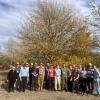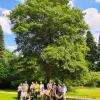Editor's Picks
Plant Focus
It was pouring rain the morning of the 4th of September, 2011. About 35 members and non-members had announced that they would attend the oak open day. However, some were obviously put off by the weather, as only around 25 showed up at the brand new visitor center of the Arboretum Wespelaar.
Arboretum Wespelaar and Herkenrode
The arboretum shelters part of the collections of Philippe de Spoelberch. Initially, the arboretum was a 15 Ha plot comprising a native oak wood planted around 1890 and an old meadow. It was landscaped in the mid 1980's. The best oaks were kept and the wood was planted with shade-loving plants. Two ponds were created in the meadow, which was planted with extensive collections, including hundreds of magnolias. This collection at Wespelaar is probably the largest magnolia collection in Europe. The arboretum was later extended by an additional 5 Ha; a poplar woodland was cleared to make room for other plants.
In 2007 the arboretum was donated to a foundation created by Philippe de Spoelberch, together with enough funding to preserve the grounds and its collections for generations to come. The arboretum is located on the outskirts of the village of Wespelaar. The foundation subsequently acquired a house adjacent to the arboretum; the house, with its back yard, is called “De Rode Poort” (‘The Red Door’). The house was completely renovated and is now the visitor center of the Wespelaar Arboretum with a direct access to the arboretum. The visitor center was officially opened to the public in April, 2011 and this is where we were welcomed on that rainy Sunday morning by Dr. Koen Camelbeke, director of the arboretum, and his staff. Koen has been working with Philippe de Spoelberch for the past ten years. Philippe also joined us for the visit. Most of those in attendance were from Belgium, but three members traveled from the Czech Republic, two from the Netherlands and two from France.
Less than fifteen minutes after we had left the visitor center, the rain kindly stopped; the rest of the day was dry, if not really sunny. Koen was our guide. Our first stop was in front of a Quercus selection called ‘Pondaim’; this cultivar is a must for any garden according to Koen. (The late Dick Van Hoey-Smith produced several clones of this hybrid between Quercus dentata x Q. pontica and at least two spectacular specimens can be admired at the Trompenburg Arboretum in Rotterdam, The Netherlands). We then walked along the pond and stopped at a group of three oaks, Q. illicifolia Wangenh., Quercus marilandica Muench., and the hybrid between the two Q. x brittonii W. T. Davis. Not far away is a bushy shingle oak, Q. imbricaria Michx., a nice plant but not typical of its habit.
We then visited a group of oaks, among which were several Quercus x hispanica Lam. cultivars: ‘Fulhamensis’, the Fulham oak, which several participants believe to be the best selection of this hybrid, then ‘Lucombeana’ and, ‘Diversifolia’. Regarding these, several participants doubted that the tree said to be ‘Diversifolia’ is correctly identified. Other oaks here are Q. stellata, a nice looking specimen and Koen’s favorite oak, Q. texana ‘New Madrid’. We then walked through the former poplar plot, now cleared, where we saw a very unhappy Q. rubra ‘Magic Fire’, a northern provenance of Q. michauxii Nutt and Q. dentata subsp. yunnanensis (Franch.) Menitsky. We also stopped to see a Quercus salicina Blume, a hardy oak which Koen feels should be in every garden. From there we crossed a dirt road to Herkenrode.

Herkenrode is Philippe’s home; it is surrounded by 9 Ha of gardens. It is here that Philippe acquired his first trees in the late 1960s, although I believe Philippe really dates the first plantings in his collection to 1972. Part of the gardens are formal gardens designed by Jacques Wirtz, a famous Belgian landscape architect who also designed the Carrousel du Louvre in Paris and the Alnwick Garden for the Duchess of Northumberland. After touring the garden at Herkenrode, we walked back to the arboretum through the native oak wood and the magnolia collection. We saw a nice 25 year old specimen of Quercus alba L., as well as Q. x bushii Sarg. We then had lunch in the cafeteria of the visitor center, after which we left for the National Botanical Garden of Belgium
The National Botanical Garden of Belgium
In Meise, we were welcomed by Dirk De Meyere, the curator of the outdoor living collections. The National Botanical Garden of Belgium has one of the largest herbaria in the world, rich in African tropical plants. Its outdoor living collections are also very extensive. In the 1980s Dirk assembled here what is probably the most comprehensive oak collection in the country. Dirk took us directly to the collection. On the way, we walked past the Castle of Bouchout on whose grounds the botanical garden was established after World War II, after it had been moved from the center of Brussels.

Dirk grouped the oaks here based on the classification of Prantl, as described in Krüssmann. Dirk says today that this was not such a brilliant idea because when classifications changes, it is not easy to group grown trees differently. Many oaks have been planted here and many have been lost. Dirk wrote an interesting article in 2003 for the yearbook of the Belgian Dendrology Society detailing his experience with the Meise oak collection, many of which are beautiful specimens.
We started with a group of three oaks of differing size and age: Quercus crispula Blume, accessioned in 1981, Q. faginea Lam., in 2005, and Q. canariensis Willd. in 1986. I am not going to name all of the numerous oaks we saw, but I will just name a few that I found remarkable. The first is Quercus aff. bicolor Willd. x Q. petraea (Matt.) Liebl., a particularly vigorous tree. Not everybody agreed on the parentage, but this was certainly a fine tree. The second is a good specimen of Q. x bushii Sarg; my third choice is a very good Q. lyrata Walter. This is the best specimen of this species that I have seen in Belgium. The collection at Meise contains many more fine oaks and is worth a visit by anyone interested in the genus. And I hope that Dirk will someday revisit his 2003 paper and publish an updated version in the journal of the IOS.
Both gardens which we visited have their inventories available on line at www.plantcol.be.















